Page 290 of 435
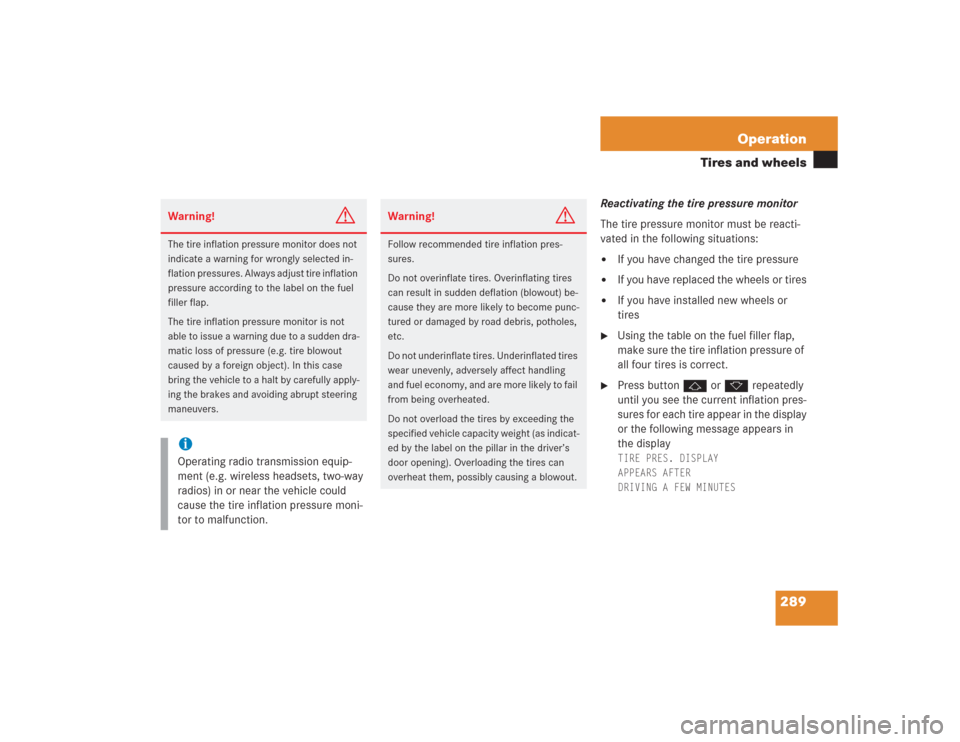
289 Operation
Tires and wheels
Reactivating the tire pressure monitor
The tire pressure monitor must be reacti-
vated in the following situations:�
If you have changed the tire pressure
�
If you have replaced the wheels or tires
�
If you have installed new wheels or
tires
�
Using the table on the fuel filler flap,
make sure the tire inflation pressure of
all four tires is correct.
�
Press button j or k repeatedly
until you see the current inflation pres-
sures for each tire appear in the display
or the following message appears in
the displayTIRE PRES. DISPLAY
APPEARS AFTER
DRIVING A FEW MINUTES
Warning!
G
The tire inflation pressure monitor does not
indicate a warning for wrongly selected in-
flation pressures. Always adjust tire inflation
pressure according to the label on the fuel
filler flap.
The tire inflation pressure monitor is not
able to issue a warning due to a sudden dra-
matic loss of pressure (e.g. tire blowout
caused by a foreign object). In this case
bring the vehicle to a halt by carefully apply-
ing the brakes and avoiding abrupt steering
maneuvers.iOperating radio transmission equip-
ment (e.g. wireless headsets, two-way
radios) in or near the vehicle could
cause the tire inflation pressure moni-
tor to malfunction.
Warning!
G
Follow recommended tire inflation pres-
sures.
Do not overinflate tires. Overinflating tires
can result in sudden deflation (blowout) be-
cause they are more likely to become punc-
tured or damaged by road debris, potholes,
etc.
Do not underinflate tires. Underinflated tires
wear unevenly, adversely affect handling
and fuel economy, and are more likely to fail
from being overheated.
Do not overload the tires by exceeding the
specified vehicle capacity weight (as indicat-
ed by the label on the pillar in the driver’s
door opening). Overloading the tires can
overheat them, possibly causing a blowout.
Page 291 of 435
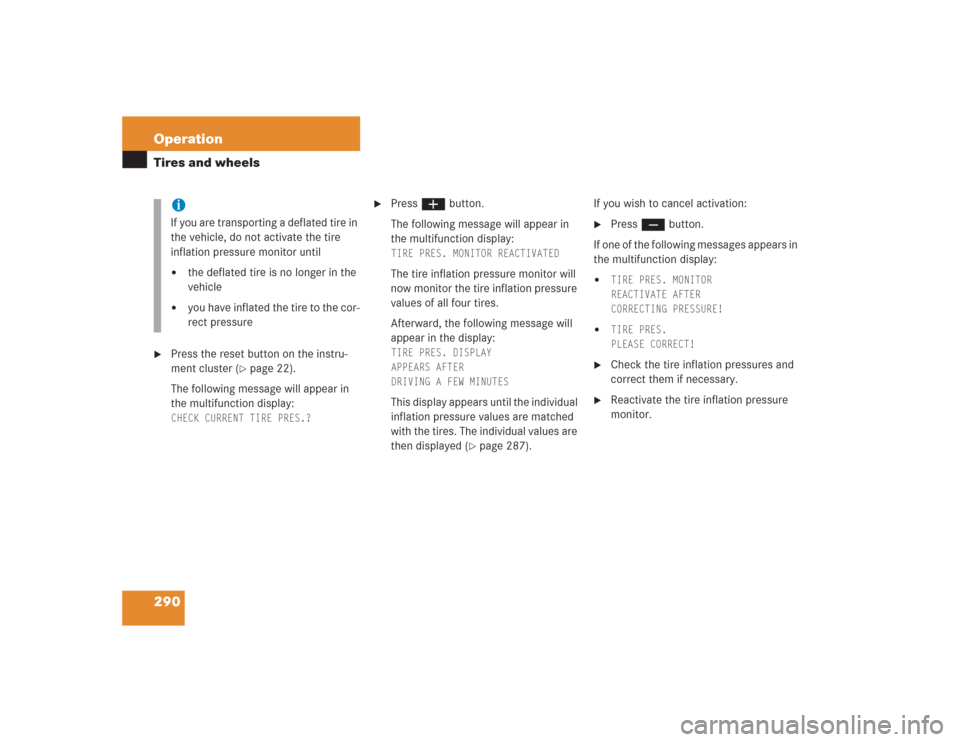
290 OperationTires and wheels�
Press the reset button on the instru-
ment cluster (
�page 22).
The following message will appear in
the multifunction display:
CHECK CURRENT TIRE PRES.?
�
Press æ button.
The following message will appear in
the multifunction display:TIRE PRES. MONITOR REACTIVATED The tire inflation pressure monitor will
now monitor the tire inflation pressure
values of all four tires.
Afterward, the following message will
appear in the display:TIRE PRES. DISPLAY
APPEARS AFTER
DRIVING A FEW MINUTESThis display appears until the individual
inflation pressure values are matched
with the tires. The individual values are
then displayed (
�page 287).If you wish to cancel activation:
�
Press ç button.
If one of the following messages appears in
the multifunction display:
�
TIRE PRES. MONITOR
REACTIVATE AFTER
CORRECTING PRESSURE!
�
TIRE PRES.
PLEASE CORRECT!
�
Check the tire inflation pressures and
correct them if necessary.
�
Reactivate the tire inflation pressure
monitor.
iIf you are transporting a deflated tire in
the vehicle, do not activate the tire
inflation pressure monitor until�
the deflated tire is no longer in the
vehicle
�
you have inflated the tire to the cor-
rect pressure
Page 292 of 435
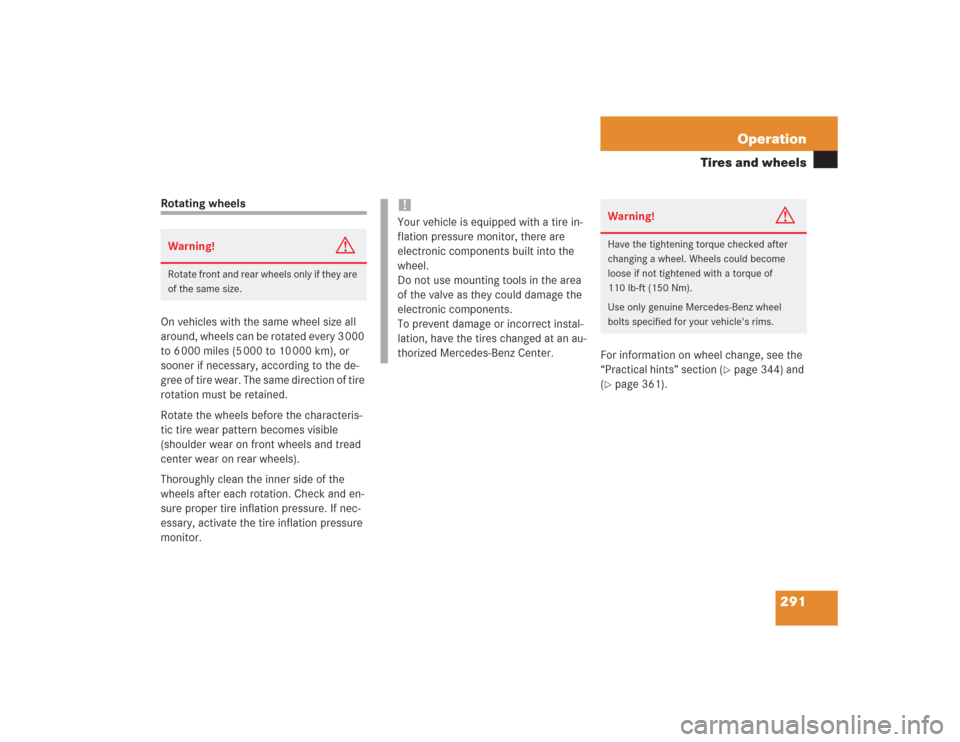
291 Operation
Tires and wheels
Rotating wheels
On vehicles with the same wheel size all
around, wheels can be rotated every 3 000
to 6 000 miles (5 000 to 10 000 km), or
sooner if necessary, according to the de-
gree of tire wear. The same direction of tire
rotation must be retained.
Rotate the wheels before the characteris-
tic tire wear pattern becomes visible
(shoulder wear on front wheels and tread
center wear on rear wheels).
Thoroughly clean the inner side of the
wheels after each rotation. Check and en-
sure proper tire inflation pressure. If nec-
essary, activate the tire inflation pressure
monitor.For information on wheel change, see the
“Practical hints” section (
�page 344) and
(
�page 361).
Warning!
G
Rotate front and rear wheels only if they are
of the same size.
!Your vehicle is equipped with a tire in-
flation pressure monitor, there are
electronic components built into the
wheel.
Do not use mounting tools in the area
of the valve as they could damage the
electronic components.
To prevent damage or incorrect instal-
lation, have the tires changed at an au-
thorized Mercedes-Benz Center.
Warning!
G
Have the tightening torque checked after
changing a wheel. Wheels could become
loose if not tightened with a torque of
110 lb-ft (150 Nm).
Use only genuine Mercedes-Benz wheel
bolts specified for your vehicle's rims.
Page 310 of 435
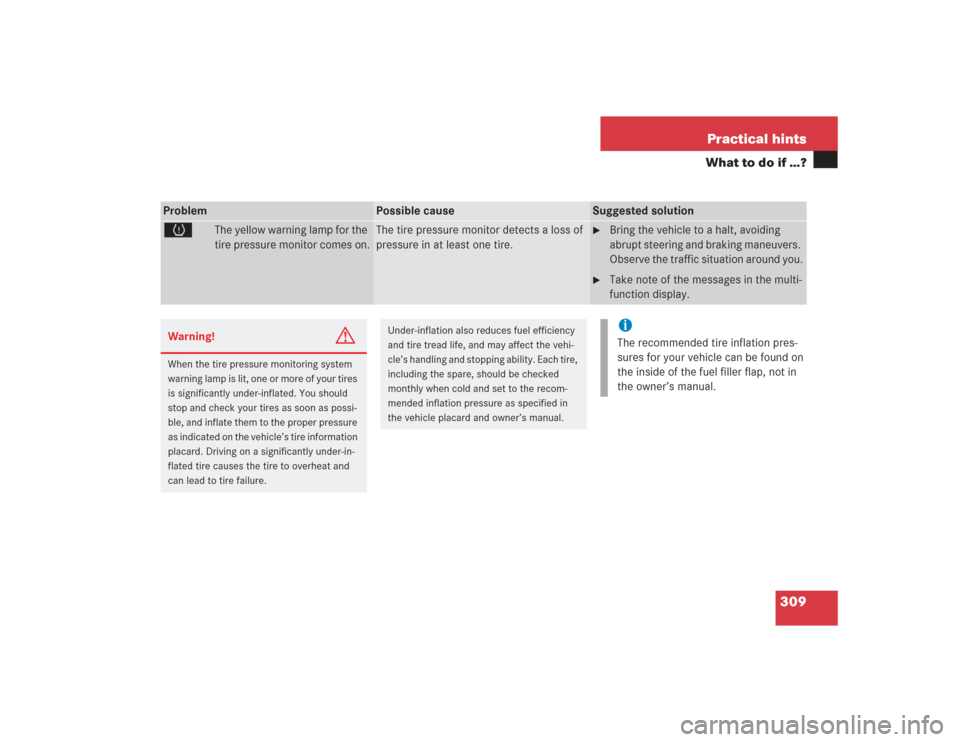
309 Practical hints
What to do if …?
Problem
Possible cause
Suggested solution
H
The yellow warning lamp for the
tire pressure monitor comes on.
The tire pressure monitor detects a loss of
pressure in at least one tire.
�
Bring the vehicle to a halt, avoiding
abrupt steering and braking maneuvers.
Observe the traffic situation around you.
�
Take note of the messages in the multi-
function display.
Warning!
G
When the tire pressure monitoring system
warning lamp is lit, one or more of your tires
is significantly under-inflated. You should
stop and check your tires as soon as possi-
ble, and inflate them to the proper pressure
as indicated on the vehicle’s tire information
placard. Driving on a significantly under-in-
flated tire causes the tire to overheat and
can lead to tire failure.
Under-inflation also reduces fuel efficiency
and tire tread life, and may affect the vehi-
cle’s handling and stopping ability. Each tire,
including the spare, should be checked
monthly when cold and set to the recom-
mended inflation pressure as specified in
the vehicle placard and owner’s manual.
iThe recommended tire inflation pres-
sures for your vehicle can be found on
the inside of the fuel filler flap, not in
the owner’s manual.
Page 336 of 435
335 Practical hints
What to do if …?
Tire pressure monitor messages
(vehicles produced up to approximately
October 2003)Display symbol
Display message
Possible cause
Possible solution
H
TIRE PRES.
DISPLAY AFTER DRIVING
A FEW MINS. REACTIVATE
USING R-BUTTON
The tire pressure is being checked.
TIRE PRES. MONITOR
NOT ACTIVE
The tire inflation pressure monitor* is un-
able to monitor the tire pressure due to�
the presence of several wheel sensors
in the vehicle.
�
excessive wheel sensor tempera-
tures.
�
a nearby radio interference source.
�
unrecognized wheel sensors mount-
ed.
�
Check the tire pressure at the next ser-
vice station.
Warning!
G
Do not drive with a flat tire. A flat tire affects
the ability to steer or brake the vehicle.
You may lose control of the vehicle. Contin-
ued driving with a flat tire will cause exces-
sive heat build-up and possibly a fire.
Page 337 of 435

336 Practical hintsWhat to do if …?Display symbol
Display message
Possible cause
Possible solution
H
TIRE PRES. MONITOR
REACTIVATE!
The tire inflation pressure monitor* is de-
activated.
�
Activate the tire inflation pressure mon-
itor* (
�page 286).
TIRE PRES. MONITOR
VISIT WORKSHOP!
The tire inflation pressure monitor* is
malfunctioning.
�
Have the tire inflation pressure moni-
tor* checked by an authorized
Mercedes-Benz Center.
�
Change the wheel (
�page 361).
A wheel without proper sensor was in-
stalled.
�
Check and correct tire pressure as re-
quired (
�page 283).
TIRE PRES.
CAUTION, TIRE DEFECT!
One or more tires are deflating.
�
Carefully bring the vehicle to a halt,
avoiding abrubt steering and braking
maneuvers.
�
Change the wheel (
�page 361).
TIRE PRES.
CHECK TIRES!
The tire pressure in one or more tires is
already below the minimum value.
The tire pressure in one or more tires is
low.
�
Carefully bring the vehicle to a halt,
avoiding abrubt steering and braking
maneuvers.
�
Change the wheel (
�page 361).
Warning!
G
Do not drive with a flat tire. A flat tire affects
the ability to steer or brake the vehicle.
You may lose control of the vehicle. Contin-
ued driving with a flat tire will cause exces-
sive heat build-up and possibly a fire.
Page 344 of 435

343 Practical hints
What to do if …?
Display symbol
Display message
Possible cause
Possible solution
H
TIRE PRES. MONITOR
REACTIVATED
The tire pressure monitor is using the cur-
rent pressure values as the basis for mon-
itoring.
TIRE PRES. MONITOR
CURRENTLY
UNAVAILABLE
The tire inflation pressure monitor* is un-
able to monitor the tire pressure due to:�
the presence of several wheen sen-
sors in the vehicle
�
excessive wheel sensor temperatures
�
a nearby radio interference source
�
unrecognized wheel sensors installed
�
Remove any extra wheel sensors from the
vehicle
As soon as the causes of the malfunction
have been removed, the tire pressure moni-
tor automatically becomes active again.
TIRE PRES. MONITOR
NOT OPERATIONAL
DRIVE TO WORKSHOP
The tire pressure monitor or a wheel sen-
sor is malfunctioning.
�
Have the tire inflation pressure monitor
checked by an authorized Mercedes-Benz
Center.
A wheel without proper sensor was in-
stalled.
�
Have the wheels checked.
Warning!
G
Do not drive with a flat tire. A flat tire affects
the ability to steer or brake the vehicle.
You may lose control of the vehicle. Contin-
ued driving with a flat tire will cause exces-
sive heat build-up and possibly a fire.
Page 366 of 435
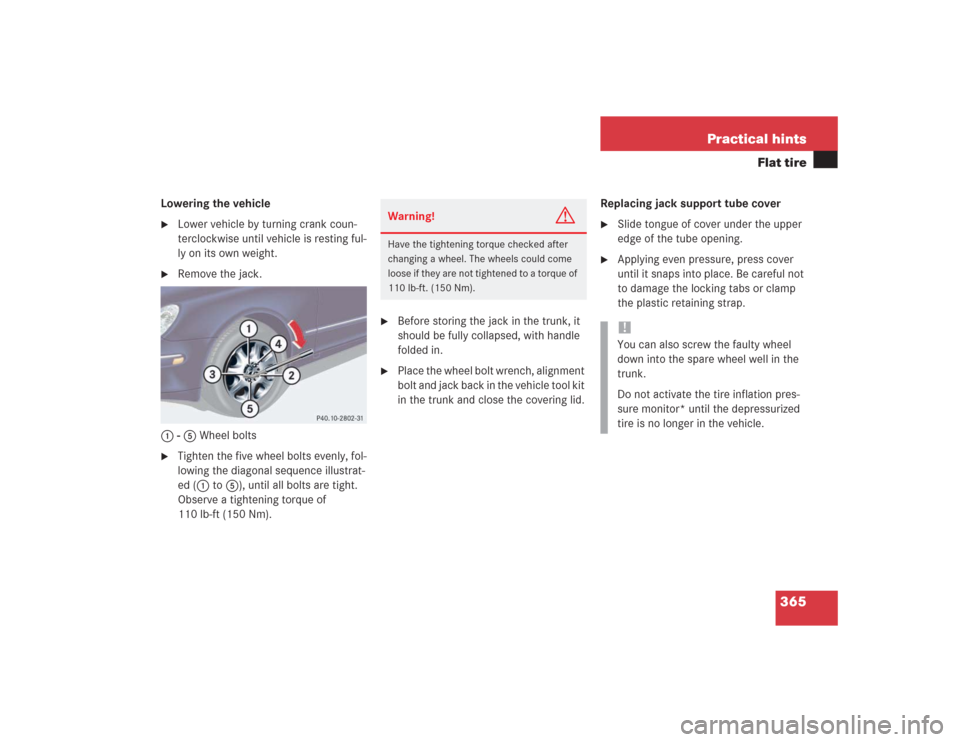
365 Practical hints
Flat tire
Lowering the vehicle�
Lower vehicle by turning crank coun-
terclockwise until vehicle is resting ful-
ly on its own weight.
�
Remove the jack.
1 - 5 Wheel bolts
�
Tighten the five wheel bolts evenly, fol-
lowing the diagonal sequence illustrat-
ed (1 to 5), until all bolts are tight.
Observe a tightening torque of
110 lb-ft (150 Nm).
�
Before storing the jack in the trunk, it
should be fully collapsed, with handle
folded in.
�
Place the wheel bolt wrench, alignment
bolt and jack back in the vehicle tool kit
in the trunk and close the covering lid.Replacing jack support tube cover
�
Slide tongue of cover under the upper
edge of the tube opening.
�
Applying even pressure, press cover
until it snaps into place. Be careful not
to damage the locking tabs or clamp
the plastic retaining strap.
Warning!
G
Have the tightening torque checked after
changing a wheel. The wheels could come
loose if they are not tightened to a torque of
110 lb-ft. (150 Nm).
!You can also screw the faulty wheel
down into the spare wheel well in the
trunk.
Do not activate the tire inflation pres-
sure monitor* until the depressurized
tire is no longer in the vehicle.